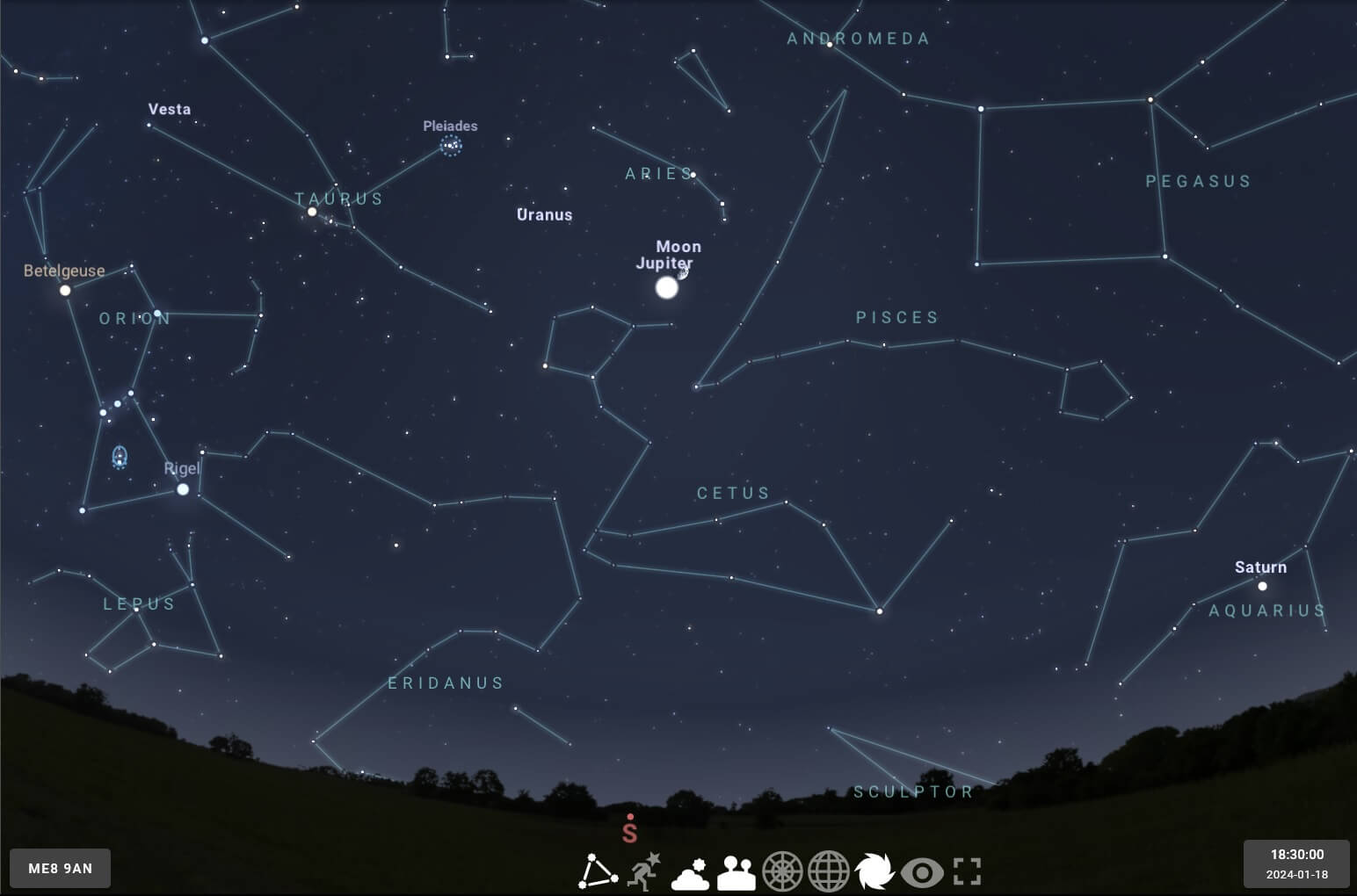TRAC Action Plan: January 2024
- Category: Action Plans
- Author: JM
- Published: 01 Jan 2024
- Last updated: 09 Jan 2024
Planets
Jupiter
Jupiter will be shining bright (mag. -2.3) all evening. We'll observe this large planet with the aim of spotting its two red/brown equatorial belts, the Great Red Spot (a huge storm), and its four large moons (Io, Europa, Ganymede, and Callisto).
Viewing provides excellent practice for refining our observational skills. This experience will prove invaluable as we prepare to put in the extra effort required to spot the fainter planets later this year.
Saturn
Saturn will be visible at the beginning of January 2024, but it will gradually become more challenging to spot as it sinks lower in the sky after sunset. By the end of the month, it will be so low at twilight that it will disappear below the rooftops.
Uranus
At mag. +5.7, Uranus will prove much more challenging to locate in the sky. It's too faint for us to be able to see with only our eyes. If we get exceptionally clear skies, we can have a go at finding this distant planet using a telescope.
Neptune
Neptune is positioned high in the sky, but its small size and faintness make it a very difficult target for us. We'll revisit Neptune in the autumn, once we've gained more experience and have formed a clear strategy for finding it.
Moon–Jupiter Conjunction
On 18 Jan 2024, the Moon will be in close proximity to Jupiter throughout the evening.
If the weather's good, we'll head out to see the conjunction at around 21:00 when bright Jupiter (mag. -2.5) will lie 1.8 degrees south of the Moon, which will be in its first quarter phase.

Image credit: Stellarium
This will be our first opportunity to witness a conjunction between the Moon and a planet, and we'll aim to capture a photo of the event. However, the Moon's size and brightness will present a challenge for our fairly basic Panasonic Lumix camera. Nonetheless, we'll give it our best shot!
Lunar Observations
Here's how the lunar calendar looks for January 2024:
- Last Quarter Thu 04
- New Moon Thu 11
- First Quarter Thu 18
- Full Moon Thu 25
Exploring the Moon
Now that most of us have observed two full moons last year, it's time to examine our nearest celestial neighbour a little more closely.
With the aid of a detailed map of the moon and a book dedicated to moongazing, we'll use the zoom eyepiece to see if we can spot some of the Moon's largest features, including prominent craters, maria, and mountain ranges.
Lunar Photography
Identifying exactly what we're looking at through the eyepiece can be fiddly and time-consuming. Taking photos will allow us to analyse what we've seen at a later time (i.e. indoors in the warm).
Capturing high-quality photos of the Moon's surface is no easy task. Phone cameras aren't designed for this type of work. We're aiming for sharp images with clear views of the Moon's topology. Achieving this will require excellent sky conditions and a calm atmosphere.
Weather Outlook
January is often one of the best months for astronomy, but it all depends on the weather. While the United Kingdom is famous for many things, good weather isn't typically one of them.
It looks like most nights in January will be cloudy and less than ideal for stargazing.
The forecast is unreliable, so we need to be spontaneous. Check the latest Met Office Cloud Cover forecast in the late afternoon, and if the sky looks clear in the evening, be prepared to wrap up and head outside!
Summary
We'll focus on the Moon and practice taking photos using our new phone adapter. Jupiter may be clear enough for us to spot its large red storm, and we'll bid farewell to our friend Saturn.
The results we get will depend on how much time and effort we put into achieving these goals, as well as factors beyond our control (i.e. the weather).
Let's aim high in January 2024 and make the most of every opportunity!
James M
TRAC Team Leader
01 Jan 2024 – Rainham, Kent

TRAC is an amateur astronomy group based in Rainham (Kent) in the United Kingdom.
On clear nights, you'll find us outside, observing stars, planets, moons, galaxies, satellites, meteors, and comets.
This action plan is specifically tailored for our location, schedules, optical equipment, level of experience, personal interests, and local sky conditions.
Unless stated otherwise, all magnitude values refer to apparent magnitude and have usually been rounded to one decimal place.
We welcome any questions, feedback, or suggestions you may have. Please let us know if anything is unclear or if you notice an error, inaccuracy, or typo. Contact us via email.
© 2024 Taverners Road Astronomy Club